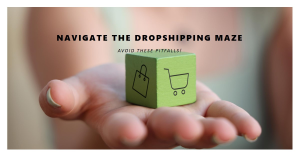Mastering the Money Game: Conquering Your Shopify Dropshipping Store Finances

Shopify dropshipping unlocks the exciting world of online commerce without the burden of managing inventory. But while inventory headaches vanish, financial responsibility takes center stage. Crafting healthy Shopify dropshipping store finances demands smart and strategic management. This guide unravels the secrets to financial mastery, empowering you to build a profitable dropshipping empire.
Shopify dropshipping store finances are one of the most important aspects of running a successful online business. Dropshipping is a business model where you sell products from third-party suppliers without having to handle inventory, shipping, or fulfillment. This way, you can focus on marketing and customer service, while your suppliers take care of the rest.
However, dropshipping also comes with its own challenges and risks, especially when it comes to managing your finances. You need to keep track of your expenses, revenue, cash flow, taxes, and profit margins. You also need to plan ahead and budget for unexpected costs, such as refunds, chargebacks, or supplier issues. If you don’t manage your finances well, you could end up losing money or even going out of business.
That’s why in this blog post, we will share some tips and best practices on how to manage your finances in a Shopify dropshipping store.
By following these tips, you will be able to run your Shopify dropshipping store more efficiently and profitably. You will also be able to avoid common financial mistakes and pitfalls that many dropshippers face. So, let’s get started!
How to set up your Shopify store and payment methods correctly?
The first step to managing your finances in a Shopify dropshipping store is to set up your store and payment methods correctly. This will ensure that you can accept payments from your customers, pay your suppliers, and track your transactions.
To set up your Shopify store, you need to choose a plan, a domain name, a theme, and a logo. You also need to create your product pages, collections, menus, and policies. You can use Shopify’s free tools and resources to help you with these tasks.
To set up your payment methods, you need to choose a payment gateway, a payment processor, and a payment method. A payment gateway is a service that connects your store to your payment processor. A payment processor is a company that handles the transactions between your customers, your bank, and your suppliers. A payment method is the way that your customers pay for your products, such as credit cards, PayPal, or Shopify Payments.
You should choose a payment gateway, a payment processor, and a payment method that are compatible with your store, your suppliers, and your customers. You should also consider the fees, the security, the reliability, and the support of each option. You can compare different payment options on Shopify’s website.
How to calculate your product costs and profit margins accurately?
The second step to managing your finances in a Shopify dropshipping store is to calculate your product costs and profit margins accurately. This will help you to price your products, monitor your profitability, and optimize your spending.
Your product costs are the total amount of money that you spend to acquire and sell your products. They include the cost of goods sold (COGS), the shipping costs, the transaction fees, and the taxes. You can calculate your product costs by adding up these expenses for each product that you sell.
Your profit margins are the percentage of your revenue that you keep as profit after deducting your product costs. They indicate how much money you make from each sale and how efficient your business is. You can calculate your profit margins by subtracting your product costs from your revenue and dividing the result by your revenue.
You should aim to have high profit margins and low product costs. This means that you are selling your products at a high price and spending less money to acquire and sell them. You can increase your profit margins and lower your product costs by finding cheaper suppliers, negotiating better deals, reducing shipping costs, choosing lower-fee payment options, and avoiding unnecessary taxes.
How to optimize your pricing and discounts effectively?
The third step to managing your finances in a Shopify dropshipping store is to optimize your pricing and discounts effectively. This will help you to attract more customers, increase your sales, and boost your revenue.
Your pricing is the amount of money that you charge for your products. It affects how your customers perceive your products, how they compare them to your competitors, and how likely they are to buy them. You should set your pricing based on your product costs, your profit margins, your target market, your value proposition, and your competitors’ prices.
Your discounts are the amount of money that you reduce from your original prices. They are a powerful marketing tool that can entice your customers to buy more, increase your customer loyalty, and clear your inventory. You should offer discounts based on your sales goals, your customer segments, your product demand, and your product life cycle.
You should optimize your pricing and discounts by testing different strategies, analyzing your data, and measuring your results. You can use Shopify’s tools and apps to help you with these tasks. You should also monitor your competitors’ pricing and discounts and adjust yours accordingly.
How to monitor your sales and expenses regularly?
The fourth step to managing your finances in a Shopify dropshipping store is to monitor your sales and expenses regularly. This will help you to track your performance, identify your strengths and weaknesses, and make informed decisions.
Your sales are the amount of money that you earn from selling your products. They indicate how well your products, your marketing, and your customer service are performing. You should monitor your sales by using metrics such as revenue, orders, average order value, conversion rate, and customer lifetime value.
Your expenses are the amount of money that you spend to run your business. They include your product costs, your marketing costs, your operating costs, and your taxes. You should monitor your expenses by using metrics such as cost of goods sold, cost per acquisition, cost per order, and profit margin.
You should monitor your sales and expenses by using Shopify’s reports and analytics. You can also use third-party tools and apps to help you with these tasks. You should review your sales and expenses on a daily, weekly, monthly, and yearly basis. You should also compare your actual results with your projected results and your previous results.
How to deal with taxes and legal issues properly?
The fifth step to managing your finances in a Shopify dropshipping store is to deal with taxes and legal issues properly. This will help you to comply with the laws and regulations of your country, your suppliers’ country, and your customers’ country. It will also help you to avoid fines, penalties, and lawsuits.
Taxes are the amount of money that you have to pay to the government based on your income and your transactions. They include income tax, sales tax, value-added tax, customs duty, and import tax. You should calculate and pay your taxes according to the tax rules and rates of each country that you operate in. You should also collect and remit taxes from your customers if required. You can use Shopify’s tax settings and apps to help you with these tasks.
Legal issues are the potential problems that you may face due to the nature of your business and your interactions with your suppliers and your customers. They include intellectual property rights, product liability, consumer protection, privacy policy, and terms and conditions. You should protect your business from legal issues by following the laws and regulations of each country that you operate in. You should also create and display your policies and agreements on your store and communicate them clearly to your suppliers and your customers. You can use Shopify’s legal templates and apps to help you with these tasks.
How to save money and grow your business steadily?
The sixth and final step to managing your finances in a Shopify dropshipping store is to save money and grow your business steadily. This will help you to increase your cash flow, improve your financial stability, and expand your market share.
Saving money is the act of reducing your expenses and increasing your revenue. It allows you to have more money available for your business and personal needs. You can save money by optimizing your product costs, your pricing, your discounts, your payment methods, your taxes, and your legal issues. You can also save money by cutting down on unnecessary or ineffective spending, such as low-performing products, marketing channels, or tools.
Growing your business is the act of increasing your sales and expanding your customer base. It allows you to have more market opportunities and competitive advantages. You can grow your business by improving your products, your marketing, your customer service, and your store design. You can also grow your business by exploring new markets, niches, or products.
Effective financial management isn’t just an option; it’s the lifeblood of your dropshipping business. By implementing these strategies, you gain control over your finances, make informed decisions, and pave the way for sustainable growth. Remember, financial mastery is a journey, not a destination.
In conclusion, beware of pitfalls in Shopify dropshipping. Explore 7 Crucial Shopify Dropshipping Mistakes Beginners Make (And How to Fix Them). Click here for insights on avoiding these errors and maximizing success.



